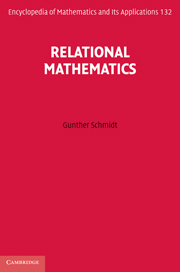Book contents
- Frontmatter
- Contents
- Notes on illustrations
- Preface
- 1 Introduction
- PART I REPRESENTATIONS OF RELATIONS
- PART II OPERATIONS AND CONSTRUCTIONS
- PART III ALGEBRA
- PART IV APPLICATIONS
- 12 Orderings: an advanced view
- 13 Preference and indifference
- 14 Aggregating preferences
- 15 Relational graph theory
- 16 Standard Galois mechanisms
- PART V ADVANCED TOPICS
- Appendix A Notation
- Appendix B Proofs postponed from Part II
- Appendix C Algebraic visualization
- Appendix D Historical annotations
- References
- Symbols
- Index
14 - Aggregating preferences
from PART IV - APPLICATIONS
Published online by Cambridge University Press: 05 May 2013
- Frontmatter
- Contents
- Notes on illustrations
- Preface
- 1 Introduction
- PART I REPRESENTATIONS OF RELATIONS
- PART II OPERATIONS AND CONSTRUCTIONS
- PART III ALGEBRA
- PART IV APPLICATIONS
- 12 Orderings: an advanced view
- 13 Preference and indifference
- 14 Aggregating preferences
- 15 Relational graph theory
- 16 Standard Galois mechanisms
- PART V ADVANCED TOPICS
- Appendix A Notation
- Appendix B Proofs postponed from Part II
- Appendix C Algebraic visualization
- Appendix D Historical annotations
- References
- Symbols
- Index
Summary
Since the development of lattice theory, it became more and more evident that concepts of upper and lower bounds, suprema and infima did not require orderings to be linear. Nevertheless, fuzziness was mainly studied along the linear order of IR and only later began to be generalized to the ordinal level: numbers indicate the relative positions of items, but no longer the magnitude of difference. Then we moved to the interval level: numbers indicate the magnitude of difference between items, but there is no absolute zero point. Examples are attitude scales and opinion scales. We proceed even further and introduce relational measures with values in a lattice. Measures traditionally provide a basis for integration. Astonishingly, this holds true for these relational measures so that it becomes possible to introduce a concept of relational integration.
With De Morgan triples, we then touch yet another closely related concept of relational methods of preference aggregation.
Modelling preferences
Anyone who is about to make important decisions will usually base these on carefully selected basic information and clean lines of reasoning. In general, it is not too dificult to apply just one criterion and to operate according to this criterion. If several criteria must be taken into consideration, one has also to consider the all too common situation that these provide contradictory information: ‘This car looks nicer, but it is much more expensive’.
- Type
- Chapter
- Information
- Relational Mathematics , pp. 368 - 395Publisher: Cambridge University PressPrint publication year: 2010



